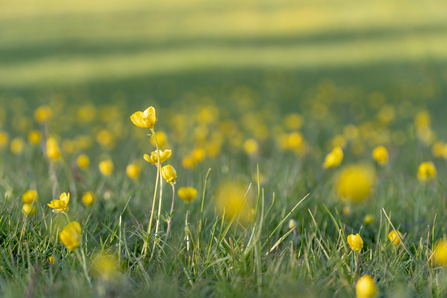Spring is full of shining things:
Bees that buzz and birds that sing;
The blackthorn bursts and blooms and glows
– All life is here, as nature knows.
Chloé Valerie Harmsworth
What to See - April
If spring could be defined by just one word, it would be excitement. Or perhaps potential.
The days lengthen and become brighter, with the intense light shining on little sparks of life: the budding trees bursting into bloom; the birds becoming increasingly numerous and vocal; the insects buzzing and flitting everywhere. Here are some natural beauties to look out for and appreciate this month.
Bee on Blackthorn blossom © Chloé Valerie Harmsworth
In early spring, the spiky Blackthorn turns snowy-white with flowers that appear on short stalks, singularly or in pairs. This is where you can see the first bees and butterflies, including the Peacock Butterfly, finding their first sustenance of the year. Following this cheery blossom, the Blackthorn’s leaves begin to appear – small, pointed and toothed. By late summer, the pollinated flowers will have transformed into blue-black marbles called sloes. The dense, thorny structure of the Blackthorn provides excellent shelter for nesting birds, as well as a buffet of insects to feed their young with.
Grey Squirrel eating unripe cherries © Chloé Valerie Harmsworth
The Wild Cherry is another one of the first trees that you’ll find covered in blossom. A wonderful sight for our eyes, the delicate white flowers dangling in clusters are an important early source of nectar and pollen for bees and other insects. After pollination, the flowers turn into cherries, initially green and then turning deep-red. At this time of year, you might spy a cheeky squirrel hanging from a branch, eating the unripe cherries! The ripe cherries are enjoyed by many birds, including the fruit-loving Blackbird, and mammals such as Badgers, Dormice and Wood Mice.

Buttercup © Frieda Rummenhohl
Buttercups (from the same family as Lesser Celandines) also begin to pop up this season, with their attractive, shining yellow petals. It was once believed that if cows grazed pastures full of buttercups, the butter created from their milk would be a very pleasing colour. And there’s also the long-asked question, ‘Do I like butter?’, which can be answered by holding a buttercup under your chin. If your skin glows yellow, then you do indeed like butter!
Small Tortoiseshell Caterpillar on Stinging Nettle © Vaughn Matthews
Well known for the itchy sting it delivers when touched, the Stinging Nettle plays a very important role in the ecosystem. Growing in large patches, it is a vital food source for the caterpillars of many of our beloved butterflies, including the Small Tortoiseshell, Peacock and Red Admiral. Reaching up to 1.2 metres in height, this plant flowers twice a year in spring and autumn, with thin catkins of tiny yellow-green to purple flowers. The Stinging Nettle spreads with the help of its seeds and through its underground rhizomes (root stalks).
This text is an adapted extract from ‘The Secret Life of a Woodland Habitat: Life Through the Seasons’ by Chloé Valerie Harmsworth.

